Zoom
Trash

Cognate object. Examples[edit] English[edit] In English, the construction can occur with a number of intransitive verbs: He slept a troubled sleep.
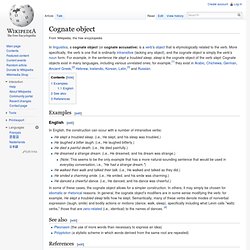
(i.e., He slept, and his sleep was troubled.)He laughed a bitter laugh. Diathesis alternation. In linguistics the term diathesis alternation or verb alternation[1] refers to the fact that verbs can be used in different subcategorization frames where they slightly change their semantic meaning.

It is a hard problem for theoretical linguistics how to encode constraints on the diathesis alternation of a specific verb to a lexicon. It is also claimed that the manner in which verbs undergo diathesis alternation can be used to identify the semantic class they belong to e.g. in a machine learning task. Examples[edit] Fred ate the pizza vs. Empty-nps. II-Pred. We say that a predication relation holds between an [srs -] constituent and whatever instantiates the [gf subj] argument of the head of that constituent.

The simplest case is the Subject- Predicate Construction: the right member of that construction stands in the predication relation to the left member. Paper1682. Index. List of syntactic phenomena. Switch-reference. Meanings of switch-reference[edit] The basic distinction made by a switch-reference system is whether the following clause has the same subject (SS) or a different subject (DS).
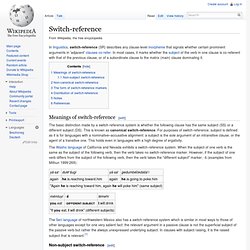
This is known as canonical switch-reference. Wh-movement. Non-configurational language. Development[edit] The concept of non-configurationality was developed by grammarians working within Noam Chomsky's generative framework. Some of these linguists observed that the Syntactic Universals proposed by Chomsky and which required a rigid phrase structure was challenged by the syntax of some of the world's languages that had a much less rigid syntax than that of the languages on which Chomsky had based his studies.[1] The concept was invented by Ken Hale who described the syntax of Warlpiri as being non-configurational.
However the first to publish a description of non-configurationality was Chomsky himself in his 1981 lectures on Government and Binding, in which he referred to an unpublished paper by Hale[2] Chomsky made it a goal of the Government and Binding framework to accommodate languages such as Japanese and Warlpiri that apparently did not conform to his proposed language universal of Move α. The distinction[edit] 11%20Luraghi%20final. Ross Constraints. Selected Papers by Haj Ross. Escher sentences: prior art. Entangledbank: More than I have. Well, Geoff Pullum and Mark Liberman have just both written about it, and there's only one of me, so I suppose that means that more people have written about this than I have.

Except that, as they both point out, that last bit is complete nonsense. But it's not ungrammatical. It seems to make perfect sense. Until you try to work out what it means. More people have written about this than I have. So what's going on? Next the scope of the 'more' has to be worked out: the canonical use is 'More people did X than did Y', so we expect something akin to VP coordination, 'Subj VP1 and VP2'; so it's logically something like 'More(Subj) (VP1 than VP2)'.
First problem. Ten Types of Grammar - Different Ways of Analyzing Language Structures and Functions - English Grammar and Usage. By Richard Nordquist Updated March 19, 2016.

Augury - Ideas and stuff. Two kinds of Two kinds of Theory I want to clarify a distinction that exists within linguistics between two major classes of theory, what I call the “nominalist” theories and the “realist” theories, and along another dimension, the distinction between derivational and representational theories.
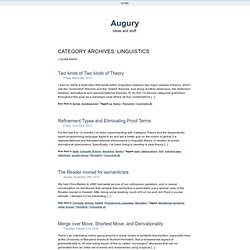
To do this, I’ll discuss categorial grammars throughout this post, as a paradigm case where all four combinations [...] Refinement Types and Eliminating Proof Terms For the last 9 to 12 months I’ve been experimenting with Category Theory and the dependently typed programming language Agda to try and get a better grip on the notion of global (i.e. representational and transderivational) phenomena in linguistic theory, in relation to purely derivational phenomena. Specifically, I’ve been trying to develop a clear theory [...] The Reader monad for semanticists Sunday, November 28th, 2010. Generative semantics. Generative semantics is the name of a research program within linguistics, initiated by the work of various early students of Noam Chomsky: John R.

Ross, Paul Postal, and later James McCawley. George Lakoff was also instrumental in developing and advocating the theory.[1] The approach developed out of transformational generative grammar in the mid-1960s, but stood largely apart from, and in opposition to, work by Noam Chomsky and his later students. This move led to a more abstract framework and lately to the abandonment of the notion of the CFG formal grammar induced deep structure. A number of ideas from later work in generative semantics have been incorporated into cognitive linguistics, Head-Driven Phrase Structure Grammar (HPSG), Construction Grammar, and into mainstream Chomskyan linguistics.[1] Using Transformational Grammar as an Editing Tool.
Using Transformational Grammar as an Editing Tool (The text version of a paper given at IPCC 95, Savannah, Georgia, on September 29, 1995) AbstractWhat's "Technical" about Technical Reviewing and Editing?
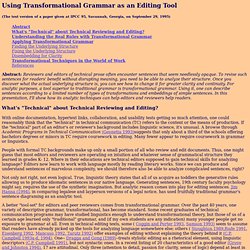
Understanding the Real Rules with Transformational GrammarApplying Transformational GrammarFinding the Underlying StructureFixing the Underlying StructureDisembedding for ClarityTransformational Techniques in the World of WorkReferencesAbstract: Reviewers and editors of technical prose often encounter sentences that seem needlessly opaque. To revise such sentences for readers' benefit without disrupting meaning, you need to be able to analyze their structure. Fis-optbind. Pylkkanen_2002. Buffalo buffalo buffalo buffalo. "From rapaport Fri Apr 14 11:37:20 1995 To: aima-bug@cs.berkeley.edu Subject: Buffalo sentence.
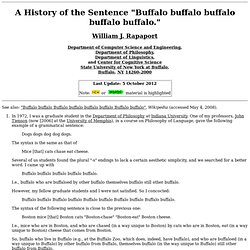
Diagrammatic excitement. « previous post | next post » An interesting Op-Ed in the NYT today by Kitty Burns Florey — "A Picture of Language", about the history of sentence diagramming: The curious art of diagramming sentences was invented 165 years ago by S.W. Clark, a schoolmaster in Homer, N.Y. HarmBrouwer. Mdt. Syntax Tree Generator. Syntax Tree Generator [S [NP This] [VP [V is] [^NP a wug]]] (C) 2011 by Miles Shang, see license. Options. PhpSyntaxTree - drawing syntax trees made easy. About phpSyntaxTree allows you to generate graphical syntax trees from labelled bracket notation phrases. You can then include the graphics into your homework or assignments. Please send your comments and suggestions to andre@ironcreek.net. Usage Enter a phrase above using labelled bracket notation. To create a node with subscript parts, separate the subscript part using the _ character.
Disable color and/or smooth lines to create a more black & white printer friendly image. News.